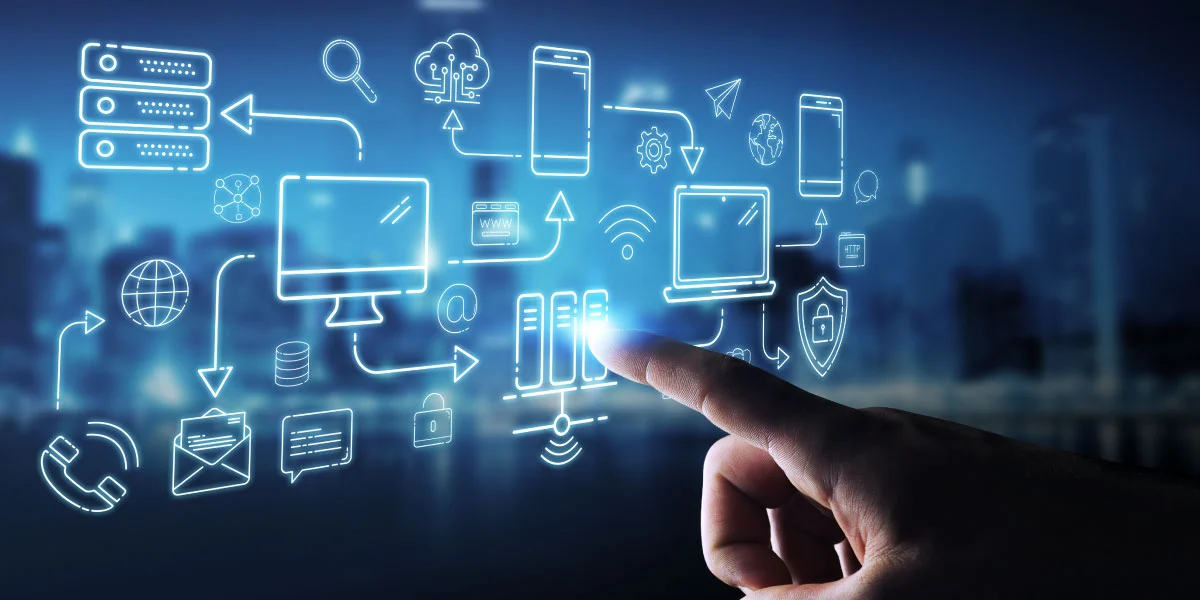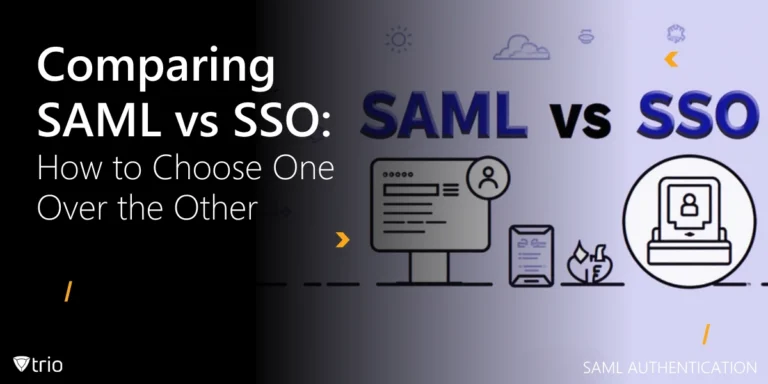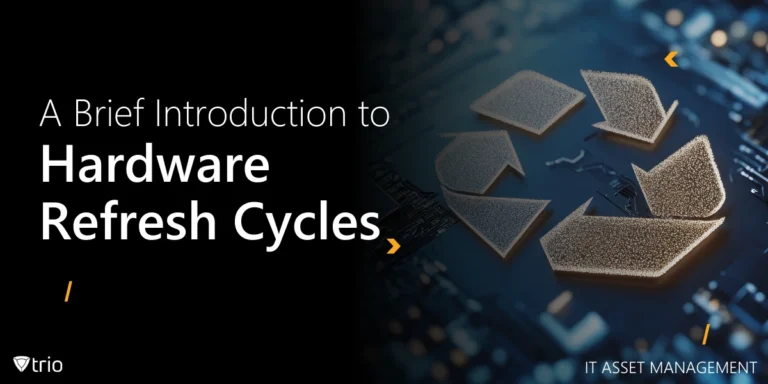How efficient is your organization’s IT infrastructure? How quickly can you respond to changes in your company? Are you getting all the value you can out of your existing devices and the software installed on them?
These are some of the questions you’re dealing with when making decisions about your company’s IT network. Technology is not cheap. They usually make up a large portion of an organization’s expenses. Therefore, it’s important to make sure you can make the most of what you’re paying for. IT asset management helps you do that and more.
In this article, we talk about IT assets and what IT asset management is. Then, we explain why your organization needs an IT asset management solution and how it can help make your IT team, assets, and processes faster and more efficient.
What is an IT asset?
Within the context of information technology, an IT asset is a piece of data, software, or hardware that makes up an organization’s IT network and infrastructure.

Here are some examples of IT assets in each category:
-
Hardware
Hardware assets are the equipment used to perform IT tasks. For instance, laptops, smartphones, mice, keyboards, printers, and Wi-Fi routers.
-
Software
These are the various programs and operating systems used to perform IT tasks. They include mobile and desktop applications, open-source software systems and databases, and cloud-based and SaaS applications.
-
Information
Any information stored on devices or online databases that is of any kind of value to the company, such as copyrighted content, financial and client data, and license agreements.
Keeping tabs on a company’s IT assets within an IT asset management framework can have a significant impact on its financial and operational success.
What Is IT Asset Management (ITAM)?
Any component of the IT environment has a finite life cycle. Hardware malfunctions, software becomes outdated, and system effectiveness suffers as a result. Therefore, IT managers need to monitor and maintain these assets regularly to ensure everything in the IT network is and remains up to speed.
Now imagine an organization with hundreds of employees. The IT network in this company will be an enormous fleet of thousands of devices and pieces of software. Managing all these assets while ensuring that everything works in an optimized way could be extremely sophisticated.
Some of the common challenges IT departments face when managing assets are as follows:
- Disorganized records and inventory blindness which includes existing equipment and software licenses.
- Constant changes in the IT network, such as new software/hardware versions and upgrades, expired licenses, and random malfunctions.
- Inefficient asset tracking and asset profiles, including data on where a device is or who is using it.
- Uninformed planning, budget allocation, and procurement.
- Lack of proper documentation in help desk and service management — i.e., history of the asset, its configuration, and its previous issues.
That is why IT-intensive organizations need to use IT asset management (ITAM) tools and frameworks to simplify managing these processes.
IT Asset Management (ITAM) is a business practice that combines financial, contractual, and inventory data to track the status of IT assets throughout their lifecycle. The goal of ITAM is to maximize the value an organization gets from Its IT assets by providing clarity and control over the IT network and its different components.
ITAM involves creating and maintaining a detailed and up-to-date log of all your IT assets in the form of asset profiles. It allows you to identify redundant assets and optimize productivity, inventory, and business funds allocation. It also helps gaining functional insights such as where a device is located, who is it assigned to, when it was last serviced, and how much it cost the company.
Overall, IT asset management lessens the burden on your IT department by mitigating the challenges at every stage of the asset life cycle.
What Are the Different Stages of the Asset Life Cycle?
Understanding the stages an IT asset goes through and the processes at work can shed light on how IT asset management makes the IT network, and in turn, the organization more efficient. The following stages are not exclusive to IT assets and basically follow the same logic as other categories of assets used in an organization.

1. Planning
At this first stage, the IT department makes decisions through careful examination of the organization’s current and future needs. Once these needs have been established, the IT department compares the various options that can meet them. Some of the key factors that are considered at this stage are how long the asset will be used, what will be its total cost of ownership (TCO), and the value the organization gets in exchange for the cost.
2. Procurement
At this stage, the decision-makers look for the best way to acquire the items chosen during the planning. During procurement, budget is given a higher priority than it was during planning and the focus will be to acquire the suitable assets at the lowest possible prices. Procurement can be done through buying, developing, licensing, or leasing an asset.
3. Deployment
Once an asset has been acquired, it needs to be installed and integrated with the organizations existing network and IT infrastructure. Additionally, deployment involves assigning the asset to its proper user and providing the user with the necessary accesses and provisions like work apps. Depending on the asset and the terms of service-level agreement, user training may also be required from the vendor.
4. Utilization
If everything goes as planned, this phase should be the longest one. An asset is now being used within the organization to carry out its intended functions.
During utilization, the users get a first-hand experience with the asset while decision-makers observe its performance.
5. Maintenance
Once the assets are deployed, preparations should be made for routine maintenance, upgrades, and repairs in order to maximize their use and value. This will increase their lifespan, reduce costs, and minimize risks.
6. Disposal
An asset is retired when reaches the end of its lifecycle and maintenance is no longer feasible. An asset can also be retired if it’s deemed obsolete and there are newer versions or better alternatives available in the market. Some of the IT asset disposition options available are recycling the asset, reselling it, or donating it to charity for tax breaks.
IT asset management solutions and frameworks help collect data, organize assets, and inform decisions at each stage of this process.
What Is an IT Asset Management Software and Why Do You Need It?
So far, we’ve gone over the complexities of IT asset management when an organization’s IT department has to keep track of hundreds or thousands of different devices and software. This task can be overwhelming and liable to errors when done manually on pen and paper or Excel spreadsheets.
Fortunately, IT asset management software is here to save the day. An IT asset management software helps companies manage and optimize planning, procurement, deployment, utilization, maintenance, and disposal of tangible and intangible IT assets.
The best IT asset management software does so by automating processes at each stage, reducing risks and human errors, saving time and operational costs, increasing the accuracy and visibility of asset performance, and improving data security.
Your organization needs IT asset management software if you are dealing with the following concerns:
You’re Paying for IT Assets You Don’t Need
As businesses rely more on various devices and software, they account for a large part of the organizations’ expenses. At the same time, it’s easy to overspend on these assets when we’re talking about thousands of different items.
For example, if your company is buying software licenses in bulk, you might be buying more licenses than you need. Also, in many cases, you might be paying for software or hardware that you rarely or never use.
According to Gartner, businesses can cut software costs by up to 30 percent if they use software license management best practices. However, applying these best practices would be extremely sophisticated and time-intensive to do manually. Instead, companies should employ software asset management tools that can save the organization many times what they cost.
You’re Still Using Excel Sheets to Manage IT
IT departments regularly log all essential data — licenses and warranty information, its configuration, who it’s assigned to, and maintenance history — on the devices or software they manage.
Traditionally, this was done using pen and paper and later Excel spreadsheets. However, as organizations rely more heavily on technology, the assets grow more numerous and varied, making the traditional ways of data logging obsolete.
Because they are liable to issues like accumulating ghost assets — assets that are listed in a business’s asset register but are not physically accounted for in the workplace. This can lead to extra tax and insurance fees that you would not need to pay otherwise.
IT asset management tools are more efficient and accurate and provide visibility in real-time — exactly what a company with a large IT fleet needs.
You Can’t Keep Up with the Changes
Usually in IT departments, a lot is happening all at once — users lose their phones, software licenses expire, computers break down and are sent out for maintenance, and printers need to be replaced with new models.
Losing track of all these changes leads to an audit and inventory nightmare! Without sufficient, organized data you won’t be able to predict the impact of all these changes and respond effectively — hampering your organization’s momentum and productivity as a result.
You’re at the Risk of License Non-Compliance Fines
Compliance with software licenses is a big challenge for companies that use third-party software. If your organization buys software from a third party for multiple users, you may be audited by the software vendor to make sure you are following the terms of your service-level agreements.
Big software companies make billions of dollars every year by looking into customers who are thought to be abusing their services. Whether or not you know about the license non-compliance cases that happen in your company, fines and penalties could hit your organization hard.
What Are the Features of an IT Asset Management Software and How Do They Help?
Now that we’ve established what IT asset management software is and why your organization needs one, let’s dive deeper into its essential features and how they help.

Automated asset detection
Most IT asset management solutions can automatically detect all hardware and software installed and connected to your IT network. Similarly, a configuration management database (CMDB) acts as a single source of truth for the entire IT network. It is a centralized database that stores information about an organization’s IT assets and the relationships between assets.
These features help IT admins gain visibility into inventory details and be able track any changes in real time.
Hardware management
An IT asset management software helps organizations track their computing assets, along with details like the product number, SKU, and date of purchase, and technical specifications like CPU type, processor speed, memory, available disk space, IP address, and numerous other parameters.
Additionally, too often companies pay for asset maintenance costs that should have been covered by warranty. ITAM tools keep tabs on warranty status of the hardware in use to prevent unnecessary costs and alert IT admins when warranties are about to expire.
Software management
Software management is a key part of an ITAM solution when it comes to saving on expenses and preventing non-compliance true-ups and fines. An IT asset management solution helps you optimize your commercial software license usage. It does so by cross-referencing the software licenses your organization is using with your license inventory.
This way you will know if you’re over-licensed —I.e., you have purchased more licenses than you actually need — or if you’re under-licensed and are liable to license infringement fines. This feature can also track software license expiration dates and alert you about taking the necessary actions.
Another key benefit of ITAM is software usage metering. This feature helps you know whether a specific software’s usage justifies its costs or you are actually paying for software that you never or rarely use. All these insights help you make more informed procurement decisions.
ITAM software also tracks the deployment of new software patches and versions, ensuring that your IT network stays secure, up-to-date, and efficient.
Help desk and service management
ITAM solutions can help with IT service management (ITSM). These tools track and log all the asset issues, repair and maintenance history. This way, the IT admin doesn’t need to start from square one every time an asset needs IT services. This data can also inform acquisition of new assets and replacement old assets.
Integration with Other Platforms
A key objective of an IT asset management solution is to remove obstacles in an organization’s network of devices. One way to achieve this is by integrating the ITAM platform with other software used in the organization such as financial, inventory, and messaging apps.
This removes hurdles in processes that involve more than one department and makes workflows smoother and more efficient.
The Bottom Line
In today’s fast-paced competition in the business sphere, taking advantage of any tool that can increase productivity and lower costs is essential to any organization’s bottom line. In such an environment, your IT infrastructure plays a key role in delivering fast and consistent quality results. This requires you to apply the best practices and tools that allow you to manage and optimize your IT network with minimum effort.
An IT asset management solution does exactly that. Leverage ITAM solutions to unleash your teams’ potential and empower your organization.
For more in-depth articles on optimizing your IT assets and processes, subscribe to our newsletter.
Get Ahead of the Curve
Every organization today needs a solution to automate time-consuming tasks and strengthen security.
Without the right tools, manual processes drain resources and leave gaps in protection. Trio MDM is designed to solve this problem, automating key tasks, boosting security, and ensuring compliance with ease.
Don't let inefficiencies hold you back. Learn how Trio MDM can revolutionize your IT operations or request a free trial today!




